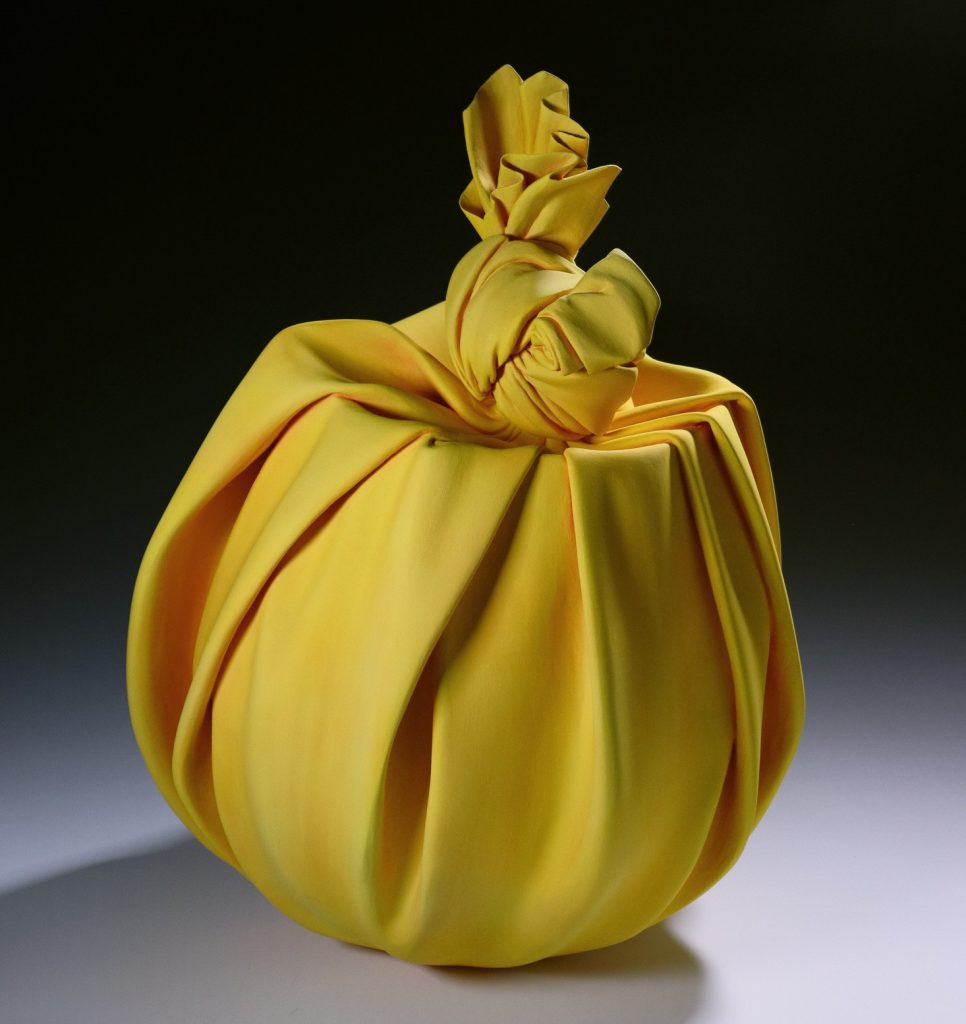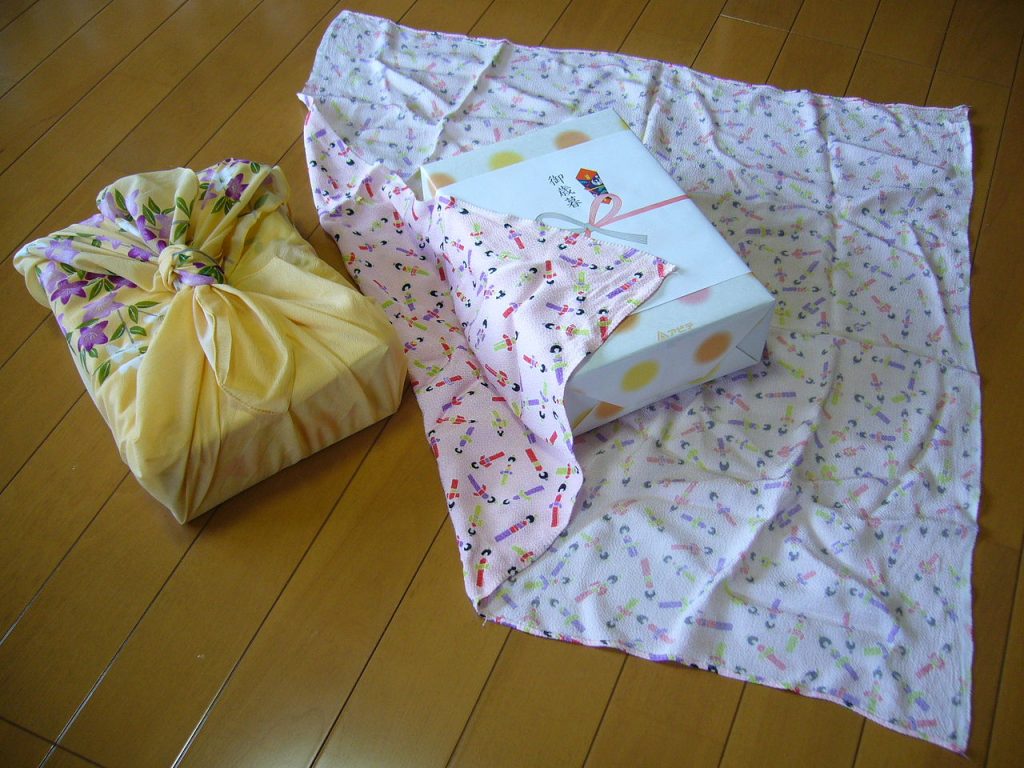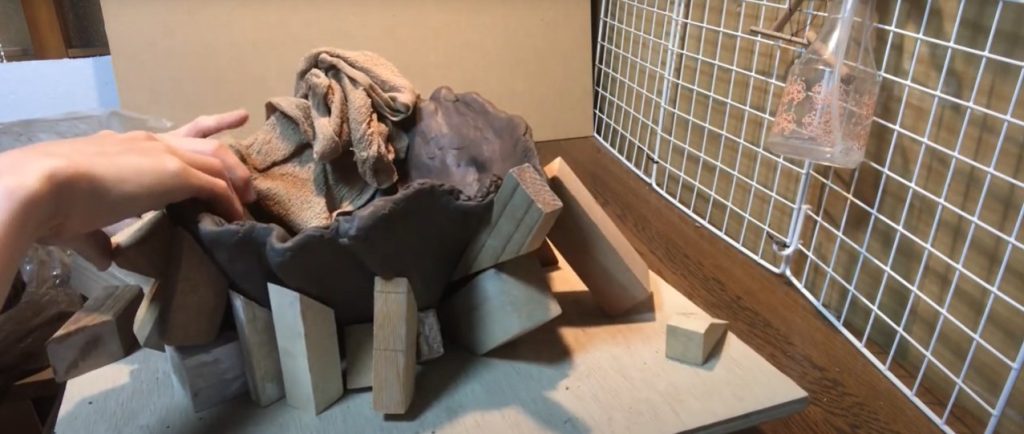Sofia Penny Curatorial Intern in the Asian art department at the Dallas Museum of Art

Tanaka Y?, Tsutsumimono (“Wrapped Item”), 2022. Glazed stoneware, 24 3/8 x 18 1/2 x 19 in. Dallas Museum of Art, Cecil and Ida Green Acquisition Fund, Susan Mead Contemporary Art Acquisition Fund, and Discretionary Decorative Arts Fund. 2023.71.
New to the Dallas Museum of Art collection, Tsutsumimono (“Wrapped Item”) by Tanaka Y? carries a deep history of the art of Japanese wrapping and connects viewers to its contemporary traditions. This ceramic glazed stoneware, measuring 24 3/8 x 18 1/2 x 19 inches, commands attention through Tanaka’s bold use of color. The work exudes a tangible presence, enhanced by the interplay of color and size. It contrasts weights—where a seemingly concealed object anchors against the light, fluid, and malleable imitation of fabric. The idea of fabric is communicated through the undulating forms that appear to ripple, roll, and curve, falling into the object, all working to conceal its form and essence from the viewer. The consistency of the clay further emphasizes the textile-like quality in its uniformity and texture. The sculpture captivates its audience as they navigate the work, allowing their imaginations to grapple with and attempt to unravel its mysterious nature.
Building on this interplay of material and illusion, contemporary third-generation Japanese ceramic artist Tanaka Y? creates clay objects resembling vessels wrapped in the traditional wrapping cloth, furoshiki. Furoshiki is a single fabric used to transport clothes, gifts, or other goods. Furoshiki enjoyed wide usage for over 1,200 years, continuing until the end of the Edo period (1615-1868 CE). The custom originates from the Nara period (710-784 CE), when it safeguarded the valuables of emperors. The oldest known wrapping cloth from the Nara period is preserved at the Shosoin, a wooden storage house at the Todaiji Temple in Nara. During the Heian period (794-1185 CE), furoshiki was used to wrap and carry clothes for the nobility. In the Muromachi period (1338-1573 CE), Shogun Ashikaga built a great steam bathhouse where noble guests used silk cloths with their family crests to keep their clothes separate while bathing. In the Edo period, public bathhouses (sento) became widespread, and furoshiki was used as a mat while undressing and as a wrapping cloth to carry clothes. The name furoshiki combines two words: “furo,” meaning “bath,” and “shiki,” meaning “to spread.” Before furoshiki became associated with public baths, people called it hirazutsumi, meaning “flat folded bundle.” Eventually, furoshiki became essential for merchants to transport their goods and served a functional role for the working class during the Edo period. Initially used to carry clothes, furoshiki evolved to wrap almost anything, symbolizing respect for others on gift-giving occasions and imbuing special meanings to the wrapping materials and the wrapped goods. Modern furoshiki are made from various materials, including silk, cotton, and synthetic fibers, with designs varying depending on their use. The most commonly used furoshiki are squares measuring 27 3/5 or 35 2/5 inches wide. While many people regard furoshikias unique to Japanese culture, similar traditions exist in other countries, such as Korea, where a patchwork wrapping cloth called bojagi has been utilized for centuries.

Modern furoshiki, Photo by Katorisi, 2007. https://en.wikipedia.org/wiki/Furoshiki#/media/File:Traditional_Japanese_wrapping_cloth,huroshiki,katori-city,japan.JPG
Furoshiki is a versatile medium for utility and personal expression and a sustainable alternative to plastic waste. After World War II, its usage declined with the rise of plastic shopping bags. However, with growing environmental awareness, furoshiki has regained popularity—compact when folded and reusable, furoshiki is an eco-friendly and convenient wrapping cloth. In 2006, Japanese Minister of the Environment Yuriko Koike introduced the Mottainai Furoshiki campaign, which loosely translates as “use a furoshiki to avoid waste,” to promote its use. Its adoption is believed to help reduce household waste from plastic bags.
The furoshiki can transform into whatever the user needs it to be. Just as the fabric can be wrapped and used in countless ways, Tanaka reflects the versatility by appearing to conceal the objects within this work, Tsutsumimono, even though the sculpture is empty inside. This deliberate concealment encourages viewers to use their imagination and speculate about what might lie hidden beneath the fabric. The artist elevates an everyday object often overlooked. Tanaka centralizes the furoshiki in her work, blurring the distinction between object and vessel. The furoshikielevates whatever it envelops, prompting consideration of its fabric and traditional significance as art in its own right. Examining the deliberate folds and Tanaka’s signature knot that sinks into the object draws one into a vision of the physical process of how the object was folded. If one knows how, almost anything can be wrapped in furoshiki, regardless of size or shape, with ingenuity and the proper folding technique. Each stage, from crafting the fabric to folding it over the object and transporting it to its destination, embodies elements of artistry and performance. With this work Tanaka brings attention to the often overlooked details. The furoshiki aligns perfectly with the Japanese cultural tradition of meticulously wrapping even the most seemingly insignificant objects, a practice that continues to thrive in Japan today.

Still from Interiors: Mysteries in Clay by Tanaka Yu, 3:25 minutes. https://www.mirviss.com/artists/tanaka-yu
While Tsutsumimono may appear slab-built, Tanaka coil-builds her forms using Shigaraki-blended clay. This method provides superior porosity and plasticity, granting her greater artistic freedom. Additionally, Shigaraki clay further infuses her work with historical depth. Shigaraki, one of Japan’s Six Ancient Kilns, is among the oldest pottery-producing regions in the country. Located at a crossroads for transportation between Nara, Yamashiro in the central Kinai region, and the Tokai region (Nagoya area), Shigaraki has continuously produced pottery from the 13th century to the present. Throughout its 800-year-old tradition, Shigaraki has primarily focused on creating utilitarian vessels. While the forms have evolved and glazes have become increasingly refined, most Shigaraki products share a common characteristic: they are large, sturdy containers meant for storage or other practical functions. Shigaraki clay underscores a continuity with the past, creating a dialogue between traditional and contemporary Japanese art. By incorporating this clay into her art, Tanaka creates an intersection of utility and beauty, compelling attention to everyday materials.
The artist’s choice to use turmeric yellow is steeped in historical significance. In Japan, people have traditionally used ukon-nuno (turmeric cloth) to wrap antique crafts because they believe turmeric repels worms and insects. Tanaka uses this same deep yellow hue to wrap her ceramic work, paying homage to the tradition. For surface treatment, Tanaka smooths the surfaces with a sponge and then applies a thin layer of clay slip using either a brush or airbrush. To achieve its distinctive deep yellow color, she applies two coats of pigment before the initial firing, repeating this process up to four times until reaching the desired hue.
She cleverly manipulates and folds her clay to imitate a textile, creating her representation of furoshiki. By doing so, she mimics the traditional process of wrapping a furoshiki around an object, blending clay sculpting techniques with the art of fabric folding. This approach combines two histories of techniques while paying homage to the cultural significance of furoshiki.
Tanaka’s works are celebrated both within Japan and internationally. They have been exhibited in several institutions and museums, garnering significant accolades for a relatively young artist in the Japanese ceramic industry. As a Kyoto Saga University of Arts student, where she earned a B.F.A. in ceramics,Tanaka initially studied oil painting but soon switched to ceramics because she enjoyed the physical demands of working with clay. She then went on to earn an M.F.A. in ceramics from Kyoto City University of Arts. Tanaka currently lives and works in Kyoto.
It is essential to recognize the broader context of the Japanese ceramic field, which has historically been dominated by men. Like many other arts and crafts in Japan, the ceramics field was often passed down through male lineage within families. Men typically held the prestigious positions of master ceramists and were the primary figures recognized for their contributions to the art form. However, the landscape has been changing, particularly since the mid-20th century. Women have increasingly entered the field, gaining recognition and acclaim for their work. Despite ongoing challenges related to gender roles and societal expectations, female ceramists have made significant contributions and continue pushing the medium’s boundaries. Notable contemporary female ceramists, such as Tanaka Y?, reflect this shift and women’s growing presence and influence in the Japanese ceramic art field.
Tsutsumimono not only honors the rich history and cultural significance of furoshiki but also reimagines it through the medium of clay. Tanaka’s innovative approach and artistic craftsmanship bridge traditional Japanese practices with contemporary art, inviting viewers to engage with the work on multiple levels. As environmental consciousness grows, the revival offuroshiki underscores the importance of sustainable practices, making Tanaka’s creations both a nod to the past and a beacon for the future. Tsutsumimono is currently on view in the Japan gallery on the Level 3. Visit the Dallas Museum of Art to experience this remarkable artwork for yourself!